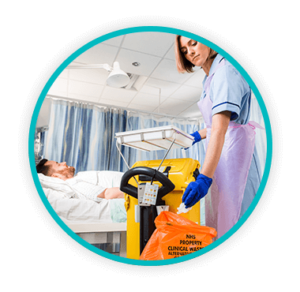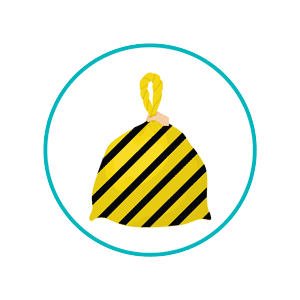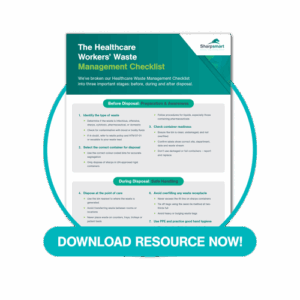The Healthcare Workers’ Waste Management Checklist

Have you ever stopped to wonder if you’re managing your healthcare waste correctly? Remove the mystery with our healthcare waste management checklist!
Compliant healthcare waste management isn’t just a back-of-house task – it’s a frontline safety issue. Every disposal decision a healthcare worker makes about clinical waste has a ripple effect that can impact infection risk, injury prevention, environmental outcomes and regulatory compliance.
Segregation mistakes, overfilled sharps containers, or misplaced waste items can all compromise the safety of clinical environments and those working or being cared for within them.
This expert-guided checklist is designed to align with the actual process of healthcare waste management, from identification through to storage – it’s also free to download.
TOPICS WE WILL COVER:
1 / Why Waste Management Matters
2 / The Healthcare Workers’ Waste Management Checklist
4 / Want More Healthcare Waste Resources?
Why Waste Management Matters
 Understanding why hospital waste management matters is crucial for anyone working within healthcare, as it affects every department and every member of staff plays a part in ensuring disposal is done correctly and in compliance with regulations.
Understanding why hospital waste management matters is crucial for anyone working within healthcare, as it affects every department and every member of staff plays a part in ensuring disposal is done correctly and in compliance with regulations.
This is precisely why all healthcare workers need awareness of best practices – effective hospital waste management is important for:
- Public health: Preventing the spread of infectious diseases both within the hospital environment and the wider community.
- Sharps injuries: NSIs remain one of the most common and avoidable clinical incidents in the UK.
- Environmental protection: Minimising the environmental impact of waste disposal and the pollution of soil, water and air.
- Downstream risk: Caused when early-stage disposal is mismanaged.
- Occupational safety: Protecting healthcare workers from exposure to hazards such as needlestick injuries and bloodborne pathogens.
- Legal compliance: Adhering to strict environmental and health and safety regulations, such as those in the Health Technical Memorandum (HTM) 07-01.
- Cost-effectiveness: Optimising waste management practices to reduce costs and improve resource efficiency.
- Sustainability: Aligning with the NHS Clinical Waste Strategy and route to Net Zero, promoting environmentally responsible practices.
The Healthcare Workers’ Waste Management Checklist
We’ve broken our Healthcare Waste Management Checklist into three important stages: before, during and after disposal.
Here in the blog is the more detailed approach, with links to our resources that contain more info on each step. Simply click here if you want to download the quick-scan checklist.
 Before Disposal: Preparation & Awareness
Before Disposal: Preparation & Awareness
#1 Identify the type of waste
Correct waste classification is crucial for preventing harm, over-treatment, and environmental damage. Consider:
- What kind of waste is this? Infectious, offensive, sharps, cytotoxic, pharmaceutical, or domestic?
- Is it visibly contaminated with blood or bodily fluids?
- Could it cause injury or infection if mishandled? Always refer to your local guidance and HTM 07-01 waste flowcharts if in doubt, or escalate to your waste lead.
Incorrect classification can lead to injury, legal non-compliance, and increased carbon footprint.
See our handy healthcare waste guides to help you identify waste like a pro:
#2 Select the correct container for disposal
Once you’ve identified your waste, matching it to the right container is of high importance as it helps to protect everyone in the waste chain.
Once waste is identified, match it to its container:
- Use the correct colour-coded system (e.g. orange for infectious, yellow for highly infectious, purple for cytotoxic).
- Sharps must go in a UN-approved rigid container. Never in soft bags.
- Always follow the correct procedures for managing liquid waste, depending on the type of liquid and whether or not it contains pharmaceuticals.
Using the wrong container increases risk for colleagues, waste handlers, and treatment facilities — and may lead to non-compliance.
See our helpful guide on hospital waste colour coding to improve your segregation game.
#3 Check container readiness
Never place waste into an unsafe bin. Before depositing your waste:
- Ensure the container is clean, undamaged, and not already full.
- Check for correct labelling (site, department, date, stream).
- If something looks wrong, don’t use it – report and replace.
Using compromised waste containers introduces risk to staff, patients, visitors and waste handlers.
During Disposal: Safe Handling

#4 Dispose at the point of care
Moving waste always increases the risk of injury and cross-contamination.
- Always endeavour to use a bin located at the point of procedure, where the waste is generated.
- Never carry clinical waste to another location to dispose of it.
- Avoid temporary placement of waste on counters, trays, trolleys – or even worse – patient beds!
Point-of-care disposal supports infection prevention and staff and patient safety. Bins should always be accessible, clearly labelled, and consistently placed.
#5 Dispose of sharps immediately and correctly
Sharps injuries are one of the most preventable workplace hazards within the clinical environment.
- Never recap needles.
- Place sharps directly into the bin after use, without delay.
- Keep the sharps container closed between use, and never exceed the fill line.
Always use sharps containers with inbuilt safety features where possible.
#6 Avoid overfilling any waste receptacle
Overfilled bins are unsafe and non-compliant and can lead to spillage, injury, and extra handling risk.
- Sharps bins must never exceed the marked fill line.
- Waste bags should be tied using the swan-tie method once two-thirds full.
- Avoid heavy, bulging bags even if less than two-thirds full.
Do you know what to do if you see an overfilled sharps bin?
#7 Use PPE and practice good hand hygiene
When necessary to use, PPE isn’t just a ‘nice-to-have’ – it protects everyone.
- Gloves are mandatory for handling any type of infectious waste.
- Use aprons and eye protection if splash risk is present.
- Always wash or sanitise your hands after handling any waste, even if you were wearing gloves whilst handling it.
Poor hand hygiene undoes even the best disposal behaviours.
After Disposal: Securing & Reporting
 #8 Secure and label containers
#8 Secure and label containers
Safe transit begins with a secure closure, so before removing waste:
- Sharps containers must be properly locked down once the fill line has been reached.
- Tie waste bags using the swan tie method before depositing them in the waste hold.
- Apply legible labels showing the site, date, and waste type.
Unsealed or mislabelled waste puts handlers and processors at risk and compromises treatment and traceability.
#9 Store waste in the designated area
Waste must be kept in secure, purpose-built areas:
- Use authorised waste hold storage rooms with controlled access.
- Store incompatible waste streams separately to avoid cross-contamination.
- Keep floors clean, dry, and free of obstructions.
Waste should never be left in corridors, stairwells, or clinical bays.
#10 Report unsafe or unclear situations
If something seems wrong, don’t hesitate to act on it:
- Report damaged bins, segregation issues, or mislabelling.
- Escalate repeat or unresolved issues to IPC teams, Estates & Facilities, or line management.
- Use incident reporting systems for serious or recurring issues, especially for incidents or risk near misses.
A strong reporting culture is crucial for preventing future harm.
#11 Support team-wide consistency
Safe disposal works better as a team behaviour as well as an individual one.
- Ensure new starters or agency staff are familiar with your facility’s waste procedures.
- Share key updates, findings from waste audits, and safety reminders regularly.
- Encourage a culture of shared responsibility, not blame.
Consistency doesn’t just reduce variation, it also reduces risk.
#12 Keep your training up to date
Clinical waste policy evolves, and you need to stay on top of it, as knowledge underpins every safe disposal decision.
- Attend all required training and refreshers as they come up.
- Stay updated on HTM 07-01, segregation policy changes, and sustainability goals.
- Make use of any digital tools, posters, or ward champions to stay current.
Remember, training shouldn’t just be a box to tick – it’s the foundation of safe practice.
Wondering how the HTM 07-01 applies to your role? See our blog on the subject.
Final Thoughts
Effective waste management isn’t just a box to tick, it’s a fundamental part of delivering safe, compliant and sustainable healthcare. Every healthcare worker plays a vital role in this process.
By using our Healthcare Workers’ Waste Management Checklist, you’re not only protecting yourself and your colleagues – you’re actively contributing to infection prevention, environmental stewardship and a stronger culture of safety.
Whether you’re new to clinical waste or a seasoned professional, small improvements in daily practices can drive meaningful outcomes. Download the checklist, share it with your team, and let it become a trusted tool in your clinical routine.
Together, we can make healthcare safer – one bin, one decision, and one team at a time.
Want More Healthcare Waste Resources?
Join our Network for Healthcare Heroes to receive more tips delivered straight to your inbox, once per month.
Some of the benefits of joining our Network for Healthcare Heroes include:
- Helpful tips and reminders for managing healthcare waste safely and efficiently
- Free educational materials and resources
- Case studies on how our partners have turned challenges into opportunities
- Up-to-date advice and information regarding compliance and legislation
- Guidance and resources to help you make healthcare safer
Let's Talk!
Your time is valuable, and we don’t want to play hard to get. You can either phone us directly on the details listed on our contact page, or feel free to fill out this short form and one of our team members will get back to you as quickly as possible.

